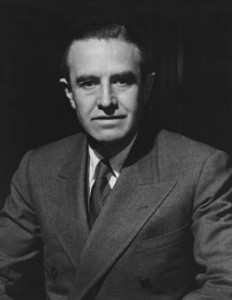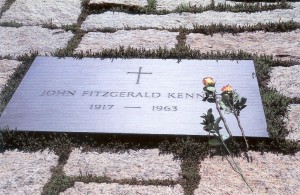ESCORTING AVERELL HARRIMAN
ESCORTING AVERELL HARRIMAN – NOVEMBER 1963
THE JOHN F. KENNEDY INTERMENT AT ARLINGTON NATIONAL CEMETERY
President John F. Kennedy was assassinated on November 22, 1963 in Dallas, Texas. The nation was in shock, and like many who lived at that time, I can vividly remember, almost to the hour, hearing the news when I was stationed in Washington, DC. The President’s remains were flown back to Washington, and he laid in state for one day in the White House and was then taken on a horse drawn caisson down Pennsylvania Avenue to the Capitol Rotunda, where he remained for another day prior to interment in Arlington, National Cemetery.
On November 23rd I took my family to the solemn Pennsylvania Avenue procession after which I returned to work at the Pentagon. On arrival I was summoned to an office, and here I was joined by 20 or 30 other navy officers. The reason? We had been selected to escort dignitaries in a motorcade from The Cathedral of St. Matthews, where a burial service was to be held, to Arlington National Cemetery across the Potomac River. We were ordered to report early next morning in full-dress white uniforms and bussed to the Cathedral where a phalanx of black limousines awaited as the dignitaries gathered. I was assigned to one of these vehicles and awaited the arrival of my charge.

My charge turned out to be Averell Harriman, a former ambassador to the Soviet Union, presidential hopeful and now an important State Department official. Harriman was a tall, distinguished looking man, well known for his diplomacy with Stalin during WWII, and for his family’s vast fortune. He had two other guests with him, whose names I do not recall. The party climbed into the back of the car and I took my place on the front seat next to the driver. Shortly thereafter the procession began to move.
This was NOT a fast moving event. The enormously long line of limousines was following the horse-drawn caisson carrying the president’s casket. The Cathedral is located several blocks north of the White House, so the long procession had to proceed south on 17th St. to Constitution Avenue, turn right passing the Lincoln Memorial, and then cross the Arlington Memorial Bridge. As the slow procession moved along, Harriman and his companions occupied the time talking politics. Once we reached the cemetery, the long line of vehicles then had to follow the narrow curving streets of the cemetery to the grave-site.
The arrival at the cemetery was interesting to me as this vast memorial was a place that I was quite familiar with. When I was attending George Washington University, in D.C., I lived in an apartment in Arlington Towers, just a short distance from the famous burial ground. The cemetery was a pleasant, quiet place, so on good days I used to take my books there to study. While doing this I eventually learned where a great many famous personages were buried.
On this solemn day, once we had crossed the Arlington Memorial Bridge and began our gradual move to the grave-site, there was a prolonged pause in the political talk in the back seat.. Since their conversation had ended, and I was in this familiar territory, I turned in my seat, excused myself and interjected that a tombstone to our right marked the grave of Air Force General Claire Chennault of Flying Tiger fame. Harriman was instantly interested, so I began pointing out other significant headstones, talked of the many horse-drawn processions I had seen and spoke about the impressive Civil War graves on the top of the hill which had very elaborate monuments on them. Harriman was a good listener and asked several pertinent and interesting questions, most of which I could answer.
Eventually we arrived at the grave-site where all the guests were disembarking. The limos were being shunted off to a designated parking area further back, but just as he was getting out of the car the Ambassador handed me a paper and a pen and asked me to write down my name and duty station, which I did. He gave me a friendly smile as he folded the note and put it into his pocket.
Imagine my surprise when about three months later I was called into the front office by my commanding officer and handed a letter that Harriman had written. It commended me and thanked me for an interesting afternoon. What a nice generous thing for a very busy diplomat to do! That letter was placed in my record and probably helped convince the Selection Board to promote me to the rank of Commander. Thank you for the letter and thank you for the memory, Mr. Harriman!
William Averell Harriman (November 15, 1891 – July 26, 1986) was an American Democratic Party politician, businessman, and diplomat. He was the son of railroad baron E. H. Harriman. He served as Secretary of Commerce under President Harry S. Truman and later as the 48th Governor of New York. He was a candidate for the Democratic presidential nomination in 1952, and again in 1956 when he was endorsed by President Truman but lost to Adlai Stevenson both times. Harriman served President Franklin D. Roosevelt as special envoy to Europe and served as the U.S. Ambassador to the Soviet Union and U.S. Ambassador to Britain. He served in numerous U.S. diplomatic assignments in the Kennedy and Johnson administrations. He was a core member of the group of foreign policy elders known as “The Wise Men”.
